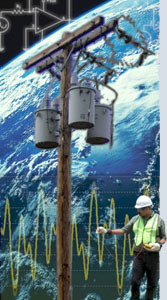Swimming Pool Handrail and Deck Shocking: Case 1
Fort Mill, North Carolina, USA
Background
The owner of a home was concerned about feeling a shock sensation whey he and his family used the handrail to get out of the swimming pool. The owner's children were getting shocked on the sides of the swimming pool. The pool had a concrete deck.
The owner build the swimming pool himself because he was familiar with heavy construction. The owner installed PVC pipe in the concrete deck to aid in the removal of the pool's ladder and handrail when the pool was closed for the winter. The owner did not use the standard bonding pipe holders. Therefore, the pool's ladder and handrail could not be bonded.
Also, several other utility customers had inquired about shocking sensations on the metal water faucets in the same subdivision.
Possible Causes
The initial investigation considered several possibilities:
- Faulty wiring on the owner side.
- Open or damaged underground primary cable neutral
- Open or damaged system neutral
Action Taken
The possible causes were ruled out by:
- Temporarily de-energizing the owner's wiring by pulling the power meter.
- Inspecting the underground primary neutral.
- Inspecting the system neutral because the area where the owner's home was located is subject to tree-related damage.
The next step in the investigation was to measure the shocking voltage and to check for proper bonding at the swimming pool. The shocking voltage was measured at 3.1 VAC from the pool's water to the handrail. The swimming pool's concrete deck, coping stone, and handrail were not bonded. The owner was informed of this lack of bonding around the swimming pool.
the next step was to measure the neutral-to-earth voltage (NEV) along the underground line at the pad-mounted transformers. The NEV measurements decreased from the open point in the loop to the termination pole, except for transformer C with a NEV of 9.0 VAC.
Normally, the decreasing NEV values indicated that the shocking voltage is related to the load. But the load on th underground single-phase line was very low.
The next step was to take current readings at pad-mounted transformer C. The results are shown in Table 1. The 1.3 ground-rod current indicated that the owner's shocking voltage was a function of the current entering the system. Also, the 5.7 VAC at the pad-mounted transformer had 1.9 ground-rod amps. The 3.9 VAC pad-mounted transformer had 0.43 ground-rod amps.
 |
| Table 1: Measurements Taken at Pad-Mounted Transformers |
The next step was to take current readings on the circuit. The results are shown in Table 2. The current readings indicate that the owner's shocking voltage was a function of current entering the system due to a voltage unbalance on the three-phase line.
 |
| Table 2: Measurements Taken at Two Points on the Circuit |
The nearby stream at Location C to Location B was providing a better neutral return path that the #6 copper on the three-phase line section from A to B.
Solutions
The solution to the owner's shocking voltage was to bond the swimming pool's concrete deck, coping stone, and handrail. Also, the #6 copper neutral from A to B should be replaced. The load on B should be open-wyed to reduce the neutral current and thus reduce the shocking voltage.

